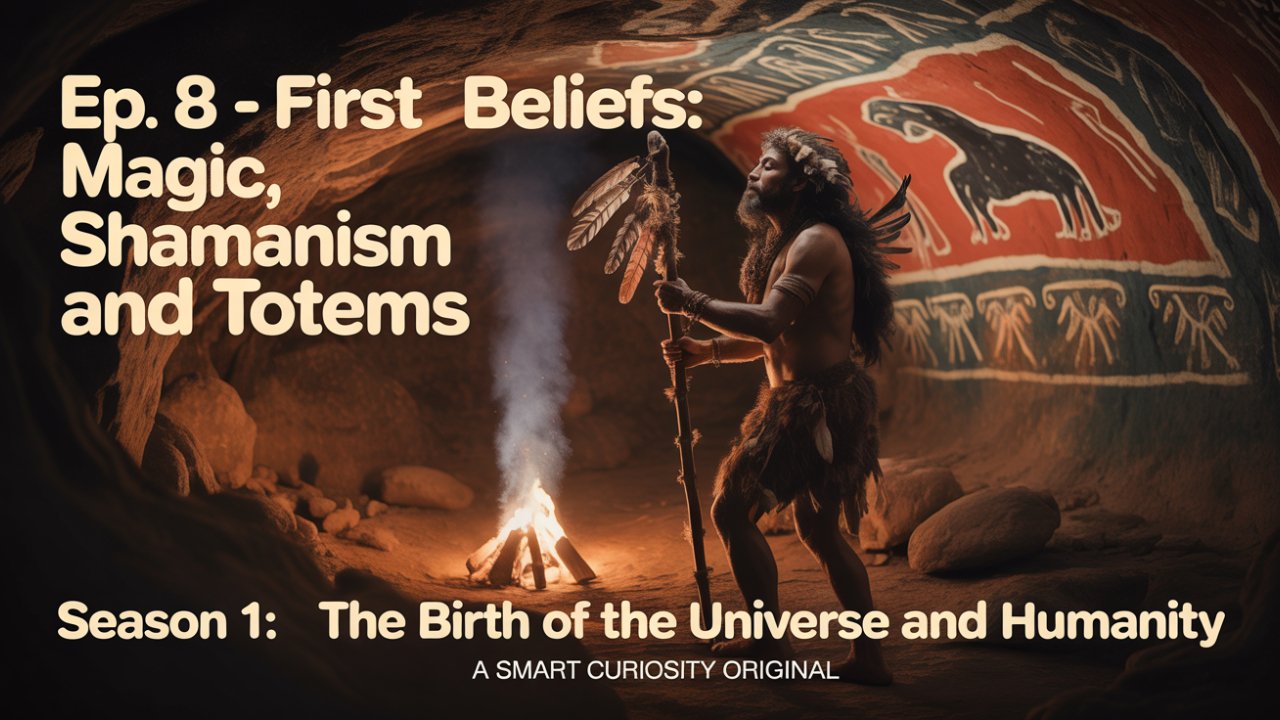Before the systematic inquiries of science, before the codification of organized religion, before a single glyph was ever carved to chronicle our history, humanity possessed a profoundly different epistemological framework for apprehending the universe. This was not an understanding derived from empirical laws or divine prophets, but from something far more immediate and participatory a perception that resonated in the rhythms of the body and was carried on the currents of the wind. Its fundamental operating principle was magic.
What if the very bedrock of human culture our artistic expression, our social structures, our conception of self was not erected by the kings or priests of our later histories, but by specialists who navigated the liminal spaces between worlds? What if humanity’s inaugural attempt to impose order on the chaos of existence was guided not by imperial decree, but by a direct communion with the myriad intelligences of the natural world, channeled through the disciplined minds and bodies of shamans?
For tens of thousands of years, this was our operational reality. It was a world perceived as being saturated with unseen forces, where every geological formation, every waterway, every living creature possessed a distinct and potent consciousness. It was a world where survival was contingent not merely on the lethality of a sharpened spear, but on maintaining a precarious and intricate equilibrium with these powerful, invisible neighbors.
In this video, we journey back to the very dawn of human consciousness. We will excavate the earliest archaeological evidence of metaphysical thought, buried deep within the earth and rendered on the walls of primordial caves. We will enter the perceptual world of the shaman, the first spiritual technologist, and investigate their indispensable role in the life of proto-historic communities. We will see how magic and ritual functioned not as abstract ideologies, but as pragmatic, operational tools deployed in the daily struggle for survival. And finally, we will decode the profound power of totems and symbols the sacred emblems that first bound our ancestors into coherent, resilient societies. This is the story of our first beliefs: a narrative of magic, shamanism, and totems.
The Dawn of Belief
Where does a belief truly originate? How does one locate the first intellectual spark of a concept as vast as a soul, or a persistence of self beyond the finality of death? The answer lies not in any text, but is interred within the geological strata of the Earth itself. For archaeologists, the initial, powerful intimations of metaphysical thought emerge from the deliberate and structured way our distant ancestors regarded their dead.
Imagine a world over one hundred thousand years ago. Existence is unforgiving, and life is brutally ephemeral. Yet, even within this severe context, something profoundly new was unfolding. At sites like the Skhul and Qafzeh caves in what is now Israel, we find the skeletal remains of early Homo sapiens. These are not, however, simply the discarded remnants of biological life. They are bodies deliberately laid to rest with clear and unmistakable intentionality. One individual is discovered clutching the jawbone of a wild boar; another is interred with a set of deer antlers meticulously arranged upon their chest. While the precise purpose remains a subject of intense academic debate, many archaeologists interpret these as deliberate “grave goods.” This practice of intentional burial, which grew more commonplace and elaborate over millennia, signifies a monumental leap in human cognition. It suggests the radical, new conception that biological cessation is not the terminus of existence. To provide implements or adornments for the deceased implies a destination where such items would be needed or valued. It hints at a journey to a post-mortem reality an afterlife and thus represents the very beginning of a dialogue with eternity.
Another powerful clue is the pervasive and cross-cultural application of red ochre, a natural iron oxide pigment. Across the globe, from Paleolithic Europe to ancient Africa, burial sites reveal bones and graves stained with this vibrant, crimson powder. Why this specific color? For many scholars, the choice is deeply symbolic, representing blood the liquid of vitality and by extension, life itself. Dusting the deceased with ochre may have been a ritual act of chromatic alchemy, a form of sympathetic magic intended to reanimate the body in a spirit realm, to ritually re-infuse it with the vital force it had lost. It is a silent, painted prayer, offered to the earth for the continuation of the spirit.
But perhaps the most spectacular window into the ancestral psyche is not in their graves, but deep within the subterranean caves they explored. These were not their living quarters. Reaching these inner chambers required crawling through impossibly constricted passages, navigating treacherous vertical drops, and abandoning the sunlit world entirely, equipped only with the flickering, unstable light of a tallow lamp or torch. What imperative drove them into such profound, sensory-depriving darkness?
What they left behind has astounded the modern world: the great galleries of Paleolithic cave art. At Lascaux in France, immense bulls and charging bison seem to thunder with silent, kinetic energy across the undulating rock walls. At Chauvet, dating back an incredible 36,000 years, we see lions, mammoths, and rhinos rendered with a breathtaking and sophisticated naturalism that betrays a deep observational intimacy. These were not simplistic decorations. They were acts of profound ritual significance, performed in the most remote, acoustically resonant, and otherworldly spaces our ancestors could possibly access.
For decades, the meaning of this art has been rigorously debated. An early, influential theory proposed it was a form of “hunting magic.” The logic was that to accurately represent an animal was to gain a measure of metaphysical power over it. A spear painted arcing toward a bison was a ritual pre-enactment, a method of ensuring success in the imminent, physical hunt. It was a ritual technology for imposing human will on the uncontrollable forces of nature.
Yet, the more we scrutinize these subterranean sanctuaries, the more complex the picture becomes. The animals depicted are not consistently the ones they predominantly hunted for food. We find apex predators like cave bears and lions rendered with the same reverence as horses or deer. And we find other, more enigmatic things. Interspersed among the magnificent bestiary are abstract symbols: grids, dots, claviforms, and strange roof-shaped signs called tectiforms. In fact, these geometric signs vastly outnumber the animal paintings. Researcher Genevieve von Petzinger has meticulously cataloged 32 specific signs that repeat across European caves over a staggering 30,000-year period, suggesting this was a shared symbolic lexicon, perhaps even a graphic syntax of the sacred a form of proto-writing.
And then there are the truly uncanny figures, the therianthropes that dissolve the ontological boundary between human and animal. The “Sorcerer” of the Trois-Frères cave is a prime example: a composite being with the antlers of a stag, the piercing eyes of an owl, a wolf’s tail, and distinctly human legs. Is this a deity? A mythical beast? Or is it, as many researchers now believe, a depiction of a shaman captured mid-ritual, in a state of ecstatic, psycho-spiritual transformation?
This theory posits that the caves themselves were sacred spaces, liminal zones that functioned as portals to another dimension. The profound darkness, the disorienting silence, and the resonant acoustics could have been intentionally used to induce altered states of consciousness, or trances. In this state, the shaman would journey to the spirit world, and the images precipitated onto the walls were not merely paintings, but visions made manifest the residue of a visionary experience, snapshots from another reality. This suggests the art was not just about hunting animals; it was about connecting with their eternal, spiritual essence.
This worldview, in which everything in nature possesses a spirit, agency, and consciousness, is known as animism. It is widely considered to be the oldest and most fundamental of human religious impulses. For our ancestors, no hard line divided the physical from the spiritual. A river was not merely a body of water; it possessed a spirit that could be benevolent or malevolent. A mountain was not just a mass of rock; it was a living entity demanding reverence. This animistic perception shaped every facet of their existence, providing a coherent framework for understanding a world that was otherwise chaotic and unpredictable. They were creating the first map of the cosmos, and at its center was a world teeming with spirits.
The Role of the Shaman
In a cosmos perceived as being alive with spirits, where the veil between the seen and unseen was permeable, a new kind of human specialist became essential. This was not a warchief or a master hunter, but an individual who could directly mediate with the non-human intelligences that truly governed the world: the spirits. This individual, this technologist of the sacred, was the shaman.
The word “shaman” originates with the Tungusic peoples of Siberia, yet the core practices represent a global phenomenon, with many scholars arguing the tradition extends deep into the Stone Age. Shamans are often considered the first true professionals. They were the original healers, mystics, storytellers, and psychologists, with these functions integrated into a single, vital role. Theirs was not a position of political power, but of immense spiritual authority an authority often acquired at a tremendous and harrowing personal cost.
What, precisely, did a shaman do? Their primary function was to act as a living bridge, an axis mundi, between the human community and the spirit world. They were masters of a specific and demanding technique: the ecstatic trance. Through the relentless psychoacoustic drive of a drum, rhythmic chanting, ingestion of psychoactive plants, extreme fasting, or dancing to the point of collapse, the shaman could intentionally and controllably alter their state of consciousness. In this state, it was believed their spirit could literally detach from their physical body and journey into the otherworld.
This spirit world was not some remote, abstract heaven. It was a parallel reality, a dimensionally co-existent landscape populated by the spirits of animals, the souls of ancestors, and the fundamental consciousness of nature itself. Here, the shaman would seek vital information, negotiate for healing, and combat malevolent forces. Their dreams and visions were not personal fantasies; they were critical intelligence reports from this other dimension, essential for the community’s survival.
One of the shaman’s most crucial duties was healing. In these early societies, sickness was rarely perceived as a purely physical ailment. It was a spiritual crisis perhaps a hostile spiritual entity had invaded the body, or more critically, the patient’s own soul had been dislodged, stolen, or had wandered away. The shaman’s task was to diagnose the spiritual cause. They would enter a trance, journey to locate the lost soul, and often engage in psychic battle with spirit adversaries to retrieve and reintegrate it into the patient. These healing rituals were frequently dramatic public performances, externalizing the cosmic struggle being waged on behalf of the afflicted person.
Shamans were also custodians of cosmic balance. They were responsible for maintaining a harmonious, reciprocal relationship with the spirits of the animals the tribe depended upon for survival. Before a major hunt, a shaman might perform a ritual to petition the “master spirit” of the game a sort of archetypal guardian of that species asking for permission to take the lives of a few of its children. They would promise, in return, that the hunters would show respect, waste nothing, and perform the proper rites over the slain animal’s body, ensuring its spirit could be reborn into the cosmic cycle.
They could also, it was believed, perceive temporal pathways. By consulting with spirit allies, they might divine the future movements of migratory herds, foresee droughts or storms, or locate lost objects. This ability to reduce the crushing uncertainty of a perilous existence made the shaman indispensable.
And upon a person’s death, the shaman acted as a psychopomp a conductor of souls. They would ritually escort the spirit of the deceased on its perilous journey to the afterlife, ensuring it did not lose its way and become a restless, tormenting ghost. This service provided immense psychological comfort and a sense of cosmic order in the face of mortality.
One did not typically choose to become a shaman. One was called, often violently and against one’s will. A person might be selected by the spirits through a sudden, debilitating illness, a near-death experience like being struck by lightning, or a series of terrifying, initiatory dreams. This “initiatory sickness” was understood as the spirits systematically breaking down and deconstructing the candidate’s profane personality in order to remake them. The candidate would endure profound isolation, fasting, and harrowing visions where they might experience being psychically dismembered by spirit beings torn limb from limb and then reassembled, piece by piece, reborn as a new entity with access to both worlds. Having traveled to the land of the dead and returned, they now possessed the map.
During a rigorous apprenticeship, they learned the secret language of the spirits, the sacred songs and chants to summon them, and the complex cosmology of their people. They acquired spirit helpers, often in the form of animals, who would serve as guides and protectors on their perilous journeys. That “Sorcerer” figure in the cave, with its blend of animal features, could be a literal depiction of a shaman embodying their spirit guides during a ritual transformation.
The shaman’s toolkit was filled with psycho-technological objects. A drum was not merely a musical instrument; it was the shaman’s sonic “steed” or “canoe,” its resonant frequencies a vehicle for modulating consciousness and carrying them to the spirit world. Masks and elaborate costumes allowed the shaman to physically transform, to embody the spirit they were channeling, thus making the invisible visible for the entire community. These were not props; they were sacred technologies for navigating and manipulating non-ordinary reality. The shaman’s life was lived perpetually on a razor’s edge deeply respected for their power, but also profoundly feared as a living conduit to the mysteries of the universe.
Magic and Ritual in Daily Life
For our Paleolithic ancestors, magic was not a realm of fantasy or superstition. It was a practical technology, as tangible and vital as the flint biface used to butcher a kill. Ritual was the primary interface for interacting with and influencing the unseen forces that governed their world. It was, in essence, humanity’s first attempt at a systematic science an operational framework of cause and effect for a world that was perceived as animate and intelligent.
This magical thinking, this applied intentionality, permeated every aspect of existence, from large-scale communal events to the most private anxieties. The hunt was the central drama of Paleolithic life, and it was steeped in magical practice. Much of it was predicated on an idea we now term “sympathetic magic,” specifically the law of similarity: the belief that an image or effigy of something participates in the reality of the thing itself. To act upon the image is to act upon the subject. This may be the core logic underpinning much of the monumental cave art.
Imagine a group of hunters preparing for a dangerous bison hunt. Deep within a sacred cave chamber, an artist-shaman paints a magnificent bison on the wall, focusing their intent to capture its very essence, its spirit. Then, the group might ritually “kill” the painting, either by drawing spears piercing its body or by throwing actual spears at the image. This was not mere target practice; it was a pre-enactment, a metaphysical assault designed to weaken the spirit of the bison, thereby rendering the physical animal more vulnerable to the hunters’ weapons in the material world.
This principle of correspondence applied to smaller, portable objects as well. The intricate carvings of animals on spear-throwers were not simply decorative flourishes. A spear-thrower carved in the form of a swift horse might be believed to mystically impart the spear it launched with the horse’s speed and power. It was a functional enchantment, an applied magical technology designed to enhance efficacy.
Fertility was another profound mystery that magic sought to influence. The survival of the group depended on the fecundity of both game animals and their own women. This preoccupation may be the key to understanding one of the most iconic and enigmatic artifacts of the Stone Age: the “Venus” figurines.
Found across a vast geographical expanse from Siberia to France, these small female statuettes, carved from stone, ivory, or bone, share a remarkable set of characteristics. They are typically faceless and have diminutive feet, but possess greatly exaggerated breasts, hips, and pregnant abdomens, like the famous Venus of Willendorf. One of the leading theories posits they were ritual objects used in sympathetic magic related to fertility. A woman hoping to conceive might carry one as a powerful amulet. A clan might utilize one in a larger ritual to promote the fertility of the group as a whole. Their anonymous, faceless nature suggests they represent not a specific person, but an abstract principle the universal, life-giving power of fecundity itself, a personification of a “Mother Goddess” archetype.
Healing was primarily the shaman’s domain, but everyday magic and folk remedies played a constant role. People wore amulets a predator’s tooth, a fossil, a strangely shaped stone to ward off illness, misfortune, or malevolent spirits. Certain plants were understood to possess not only medicinal properties but also a resident spiritual power. A healing ritual wasn’t just about applying a poultice; it was about speaking the correct incantations to respectfully persuade the plant’s spirit to lend its aid.
Ritual also provided the structure for social life and reinforced communal bonds. Rites of passage, particularly initiation ceremonies, marked the difficult and dangerous transition from childhood to adulthood. An adolescent boy might be taken into the wilderness, forced to endure orchestrated hardship and isolation, and be taught the tribe’s sacred myths, with the powerful cave paintings serving as mnemonic architecture for this esoteric knowledge. The objective was to psychologically deconstruct his identity as a child and ritually rebuild him as an initiated, adult member of the collective, fully integrated into his society’s shared reality.
Even the mundane act of crafting a tool could be imbued with ritual significance. The flintknapper might perceive himself as coaxing the blade from the stone, not by brute force, but by following the spirit immanent within the material itself. All of this is predicated on the foundational belief that humanity is not separate from nature, but is deeply enmeshed within it, and that human intention, focused through the lens of ritual, can influence reality. We might dismiss this as superstition, but it served a vital psychological function. In a world of constant, life-threatening uncertainty, magic and ritual provided a profound sense of agency. It gave our ancestors the conviction that they were not merely passive victims of fate, but active participants in the unfolding of their own destiny.
The Power of Totems and Symbols
As human communities expanded, they required a robust system for defining group identity and regulating social relations. Who are we? To whom are we related? Long before the invention of flags, crests, or nations, our ancestors devised a powerful socio-spiritual framework for this purpose: totemism.
Totemism is a complex belief system wherein a social group, such as a clan, holds a mystical, kinship-based relationship with a specific natural entity, typically an animal or plant their totem. The word derives from an Ojibwa term meaning “brother-sister kin,” which elegantly captures the essence of the bond. Members of, for instance, the Bear Clan would understand themselves not as people who merely revered bears, but as literal descendants of a primordial, mythical Bear ancestor. This conviction of consubstantiality of sharing the same essential substance made all clan members, in a very real sense, brothers and sisters.
This totemic bond was a primary organizing principle of their lives. First, it dictated marriage rules. A man from the Bear Clan was strictly forbidden from marrying a woman from the same clan; they were considered blood relatives. This rule, known as exogamy, was a crucial social technology for weaving disparate clans into wider social networks and political alliances, preventing social entropy and fostering genetic diversity. Your totem was your fundamental social identifier.
The totem animal itself was treated with profound respect and reverence. For the Bear Clan, all bears were considered sacred kin. It was typically taboo to hunt or eat a bear, except on rare, highly ritualized ceremonial occasions where the act was framed as a communion with the ancestral spirit. To harm the totem animal was to inflict metaphysical harm upon the clan itself. The clan’s origin myths would revolve around the great Bear ancestor, explaining their identity, their place in the cosmos, and the behaviors and moral codes expected of them. Bear Clan members might even believe they shared the bear’s essential qualities, such as strength, solitude, and courage.
While direct, unequivocal proof of totemism in the Paleolithic era remains elusive, the art is saturated with suggestive evidence. The intense, almost obsessive focus on animal imagery suggests a relationship far deeper than that of hunter and prey. The 40,000-year-old Lion Man sculpture from Germany, a hybrid human body with a lion’s head, could certainly represent a shaman in a state of transformational trance, but it could just as easily be an effigy of a revered, mythical ancestor of a Lion Clan.
This was all part of a larger, burgeoning symbolic universe. Our ancestors were thinking in symbols, using them to structure their world and communicate complex ideas long before the advent of writing. We see this most clearly in the abstract signs painted and engraved on cave walls. These were not random doodles. The fact that the same 32 signs appear repeatedly across thousands of miles and tens of thousands of years is powerful evidence that they constituted a shared vocabulary of meaning a graphic communication system.
They could have been clan signs, ritual signatures, or even schematic maps of terrain or the cosmos. A series of dots might track lunar cycles, functioning as a primitive calendar. The cave walls may have been the first libraries, repositories for the accumulated wisdom and mythology of a people, encoded in a symbolic system that allowed for displaced reference the ability to communicate about things not immediately present in time or space.
This capacity for symbolic thought allowed our ancestors to construct shared cultures and collective memories. The totem was more than an animal; it was a symbol of unity, of a common history and a shared destiny. It provided the group with a sacred origin story, rooting their social identity in the timeless, mythological world of the Dreamtime or the First Creation. This impulse to live by and through symbols is a fundamental human trait. The totem pole, the eagle on a Roman standard, the modern national flag they all spring from this ancient, primal need to declare “we are one” through a shared, sacred symbol. For our ancestors, this symbolic world was as real and as consequential as the physical one. It was the invisible scaffolding upon which the first human societies were built.
From the first intentional burials that defied the finality of death, to the breathtaking art that illuminated the profound darkness of subterranean cathedrals; from the pragmatic magic that offered a locus of control in an uncertain world, to the shamans who walked between realities; and to the powerful totems that forged the first collective human identities the story of our first beliefs is ultimately the story of the birth of the human imagination.
It was a worldview born from a deep and participatory intimacy with nature, a perception of the cosmos as a single, vibrant, and interconnected entity. In this world, there were no rigid demarcations between human and animal, physical and spiritual, the living and the dead. It was here, in this fluid and animate reality, that the core components of human culture were forged: our drive to explain the world, our quest for meaning, the comfort of community, and our enduring awe in the face of the unknown.
These first beliefs are not merely relics of a bygone era. They are woven into the very fabric of who we are today. The shaman’s journey a deliberate descent into darkness to retrieve a gift of knowledge or healing for the community is the archetypal grammar for the hero’s journey that echoes through our own myths and modern cinema. The conviction that there is more to reality than what our senses perceive continues to fuel religious and spiritual inquiry across the globe. And the power of symbols to unite and divide us remains as potent as it ever was.
Our distant ancestors looked out at a mysterious and often terrifying universe and, rather than shrink from its immensity, they sought to engage with it, to understand it, and to find their place within its grand, living tapestry. They created a world saturated with meaning, humanity’s first, and perhaps most profound, attempt to make a home in the cosmos. If you found this journey into our deep past meaningful, please give this video a like to help others discover it. For more explorations into the deep history of human culture, be sure to subscribe and ring the bell so you don’t miss what’s next. Thank you for watching.





